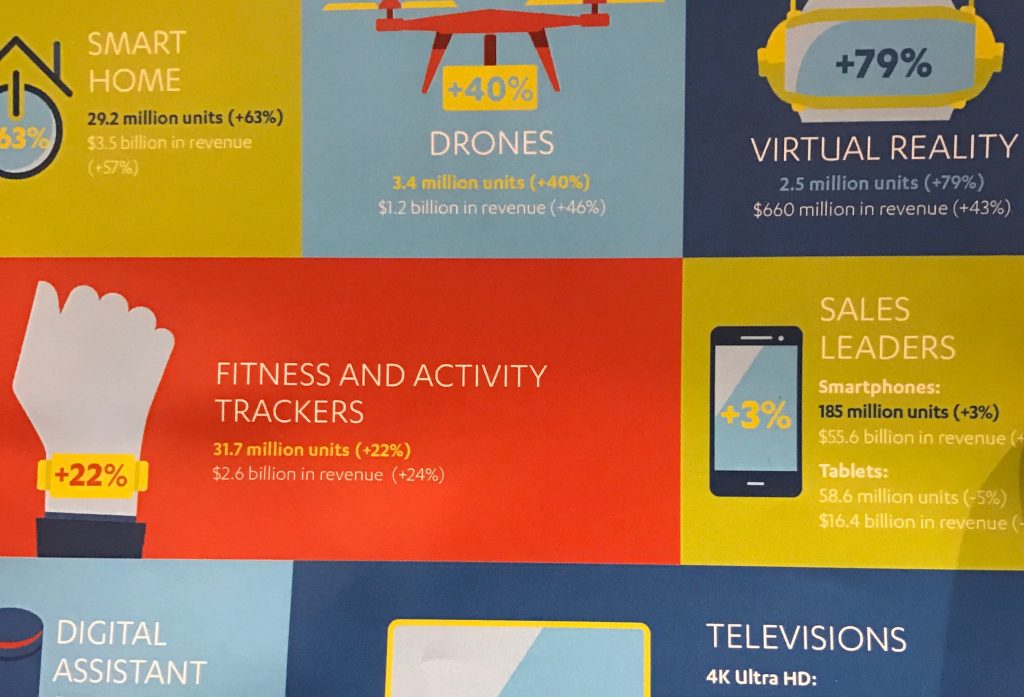
Stuff is getting smarter. It’s getting more connected. And it’s starting to talk back to us.
Those are just a few of the tech trends that the CTA’s chief economist, Shawn DuBravac, highlighted last night at a kick-off event for CES, the Consumer Electronics Show, in Las Vegas.
And all of them will have an impact on how marketers reach customers.
1: Voice in computing
In 1994 Microsoft started working on voice recognition. The error rate would be laughable if it wasn’t so pathetic: almost exactly 100%.
19 years later, in 2013, we had come much closer to solving this challenging problem. But the error rate was still 23% — too high to make conversational user interfaces possible.
Today, the error rate is at what DuBravac calls “human parity” levels: 5% or less.
That means we can dictate texts to Siri. That means we can ask Alexa to dim the lights. That means we can tell Google Assistant what we need, and Google can help us. And it means that Cortana could possibly be as helpful as her Halo-inspired namesake.
Marketers need to think now about how people will research and purchase products, services, and experiences in 2017 and beyond. In addition, marketers need to get even deeper integrated into product development, since customer experience is part of customer satisfaction, and a core part of retention, word-of-mouth marketing, and reviews and ratings.
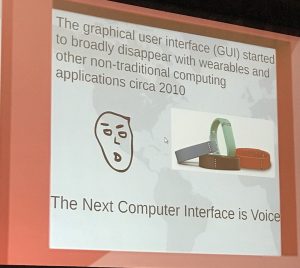 When we can converse with our products, and when we can purchase things by telling a home assistant or a smart agent to buy something, the game has changed.
When we can converse with our products, and when we can purchase things by telling a home assistant or a smart agent to buy something, the game has changed.
Interesting note:
DuBravac says the graphical user interface we all know and love “started to disappear in 2010.”
If that’s surprising to you, think fitness tracker bands that you tap on, or that alert you to move with a buzz. Wearables like these were the (very) thin edge of the wedge.
Voice will be the primary user interface for home robots — which will hit five million units in 2020 — and home assistant hubs, which will double in market penetration in 2017.
In addition, while there are about 1,500 applications (or skills) for Amazon’s Alexa right now, another 700 or so will launch this week at CES.
2: AI infusion
Artificial intelligence is also changing products and experiences. It’s getting infused into more and more products, where it will — when successful — continuously improve customer experience.
While in many ways AI will function in the background — there’s a fridge launching this week that will use machine learning and sensors to optimize temperature and humidity inside based on varying conditions in your home and regions — its most visible impact on our life will be via the conversational interfaces mentioned above.
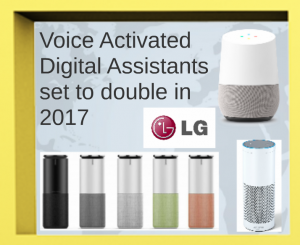 Via machine learning, AI is finally getting useful at significant tasks. Microsoft, for example, uses AI to manage real-time language translation between 60 languages.
Via machine learning, AI is finally getting useful at significant tasks. Microsoft, for example, uses AI to manage real-time language translation between 60 languages.
But it’s not a panacea, and it’s not always beneficial.
Marketers will already be used to vendors talking about AI-driven enhancements to their marketing tools and platforms, and will have to be careful. DuBravac uses the following criteria to measure potential impact. Marketers can use them to to evaluate if a marketing buzzword will translate into real impact:
- Depth of knowledge
How deep is the system’s knowledge? How much data is it based on? - Fluidity of conversation
If it’s a conversational user interface, how good is it? How seamless is communication? - Value of recommendations
Are the tool’s recommendations better than ones you would have made yourself? - AI-infused adjustments
If the tool is making incremental changes, how good are they? - Depth of change
Over time, does this tool improve your ROI?
3: Connections and computations
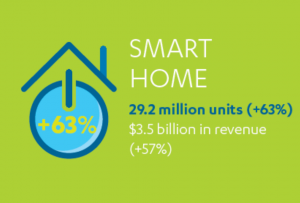 The smart home market is growing. The smart city market is growing. And wearables — smart tech on our bodies — are growing. All of this requires significant infrastructure to manage communication, and significant computation to aggregate and assess all the new data pouring it.
The smart home market is growing. The smart city market is growing. And wearables — smart tech on our bodies — are growing. All of this requires significant infrastructure to manage communication, and significant computation to aggregate and assess all the new data pouring it.
The question is: How can marketers connect to this mesh of technology?
If someone has a smart home, can your product connect to it? How does your app integrate into Alexa or Google Assistant, or work with Siri? Or, how can your tool or appliance or service get smarter and more useful by connecting to other tools or services, via, perhaps a technology like Button?
One of the major benefits here: aggregated learning.
As DuBravac highlighted, when one of Google’s self-driving cars sees something new that it needs to learn, all of Google’s cars see it. Since Google’s vehicles have collectively driven about two million miles, seen 200,000 stop signs, 600,000 traffic lights, and 180 million other vehicles, individually they all have too.
How can your product get smarter, faster, using aggregated learning? And then, how can you market the improvement?
4: Transportation transformation
Uber. Self-driving vehicles. Drones.
There’s new tech for transportation every single day. Changing how we move and how we transport goods and services will have impacts for marketers as well as product developers.
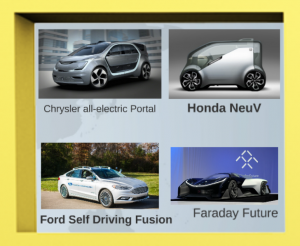 One company at CES, WayRay, just announced a partnership with Harmon — the audio company just acquired by Samsung — to bring its augmented reality windshield technology to cars globally. That augmented or mixed reality will show points of interest, routes, driving information … and restaurants, shopping, and more.
One company at CES, WayRay, just announced a partnership with Harmon — the audio company just acquired by Samsung — to bring its augmented reality windshield technology to cars globally. That augmented or mixed reality will show points of interest, routes, driving information … and restaurants, shopping, and more.
For fully autonomous self-driving cars, the technology will even at some point be able to transform the driving experience entirely with an immersive video and audio experience on all windows. You could be driving through downtown Detroit, for instance, but be looking at Miami. You could be watching a movie, engaging in a little VR-enhanced Facebook time, or shopping.
All of which, of course, have implications for marketers.
5: Digitizing the consumer experience
As I mentioned at the top of this post, stuff isn’t just stuff anymore. It senses. It’s smart. And it talks.
And that’s digitizing the consumer experience.
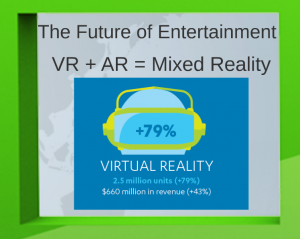 Sure, that includes virtual reality, augmented reality, and mixed reality. But it’s far beyond these still bleeding-edge experiences. Carnival — the cruise ship company — is exhibiting at CES for the first time because they have digitized the vacation experience and given guests data, access, and control via apps and other interfaces.
Sure, that includes virtual reality, augmented reality, and mixed reality. But it’s far beyond these still bleeding-edge experiences. Carnival — the cruise ship company — is exhibiting at CES for the first time because they have digitized the vacation experience and given guests data, access, and control via apps and other interfaces.
Hilton has done some similar things with its Digital Key technology, enabling you access your room via the Hilton app on your smartphone.
The interesting thing for marketers?
When you digitize the consumer experience, you can collect data on usage and satisfaction. That informs future product development, but also what marketing should focus on. And, it potentially embeds the opportunity for social sharing and micro-influencer marketing right into the flow of product use.
The only constant is change
Marketers already know that the only constant today is change. The pace is accelerating, and the places we need to now reach out to current and potential customers are changing — as are the ways we’re connecting with them.
Author
Before acting as a mobile economist for TUNE, John built the VB Insight research team at VentureBeat and managed teams creating software for partners like Intel and Disney. In addition, he led technical teams, built social sites and mobile apps, and consulted on mobile, social, and IoT. In 2014, he was named to Folio's top 100 of the media industry's "most innovative entrepreneurs and market shaker-uppers." John lives in British Columbia, Canada with his family, where he coaches baseball and hockey, though not at the same time.




Leave a Reply
You must be logged in to post a comment.